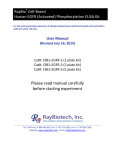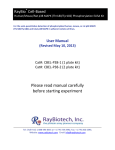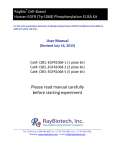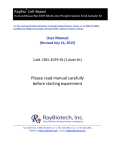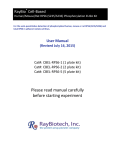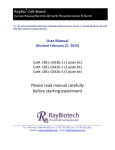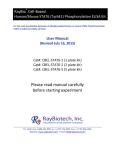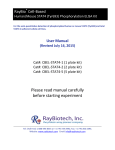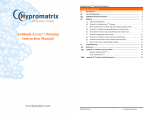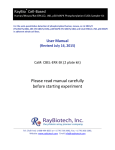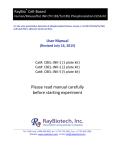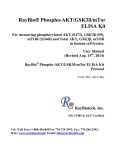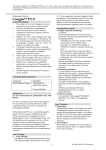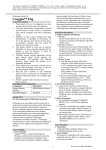Download data sheet
Transcript
RayBio® Cell-Based Human/Mouse/Rat STAT3 (Tyr705) Phosphorylation ELISA Kit For the semi-quantitative detection of phosphorylated human, mouse, or rat STAT3 (Tyr705) and total STAT3 in adherent whole cell lines. User Manual (Revised May 10, 2013) Cat#: CBEL-STAT3-1 (1 plate kit) Cat#: CBEL-STAT3-2 (2 plate kit) Please read manual carefully before starting experiment Tel: (Toll Free) 1-888-494-8555 or +1-770-729-2992; Fax: +1-770-206-2393; Website: www.raybiotech.com Email: [email protected] Cell-Based Human/Mouse STAT3 (Tyr705) Phosphorylation ELISA Kit TABLE OF CONTENTS I. II. III. IV. V. VI. VII. VIII. IX. X. Introduction…………………………………………............................................... How It Works……………………………………………………………………………………. Reagents and Storage.…………....................…………...................... ... Additional Reagents Required…………...................................... Reagent Preparation …………........................................................... Assay Procedure ……………………………………………………………………......... Assay Procedure Summary ………………………………………............... Quality Control Data ………………………………………………..................... References …………………………………………………………………......................... Troubleshooting Guide ……........................................................... 1 RayBio Cell-Based STAT3 (Tyr705) ELISA Kit Protocol 2 3 4 4 5 6 9 10 12 13 I. INTRODUCTION Protein phosphorylation is instrumental in the regulation of protein activity within a cell. It plays important roles in the living cells including proliferation, differentiation and metabolism. A large number of protein kinases and phosphatases have been extensively investigated, and have been shown to be involved in signal transduction pathways. The RayBio Cell-Based STAT3 (Tyr705) ELISA kit is a very rapid, convenient and sensitive assay kit that can monitor the activation or function of important biological pathways in cells. It can be used for measuring the relative amount of STAT3 (Tyr705) phosphorylation and screening the effects of various treatments, inhibitors (such as siRNA or chemicals), or activators in cultured human, mouse, and rat cell lines. By determining STAT3 protein phosphorylation in your experimental model system, you can verify pathway activation in your cell lines without spending excess time and effort in preparing cell lysate and performing an analysis of Western Blot. In the Cell-Based STAT3 (Tyr705) ELISA kit, cells are seeded into a 96 well tissue culture plate. The cells are fixed after various treatments, inhibitors or activators. After blocking, Anti-Phospho-STAT3 (Tyr705) or Anti-STAT3 is pipetted into the wells and incubated. The wells are washed, and HRPconjugated anti-mouse IgG is added to the wells. The wells are washed again, a TMB substrate solution is added to the wells and color develops in proportion to the amount of protein. The Stop Solution changes the color from blue to yellow, and the intensity of the color is measured at 450 nm. See Figure 1 below for an illustration. 2 RayBio Cell-Based STAT3 (Tyr705) ELISA Kit Protocol II. HOW IT WORKS 1. Add cells 4. Anti-phospho-protein antibody or anti-pan-protein antibody 2. Treatment with stimulators or inhibitors 3. Fixing and blocking 5. HRP-conjugated secondary antibody 6. Develop with substrate Fig.1. Cell-Based protein phosphorylation procedure 3 RayBio Cell-Based STAT3 (Tyr705) ELISA Kit Protocol +TMB Color III. REAGENTS AND STORAGE Store entire kit at ≤ -20 °C immediately upon arrival. Kit must be used within the 6 month expiration date. Avoid repeated freeze-thaw cycles. ITEM A B C D E F G H I J K COMPONENT Uncoated 96-Well Microplate 20X Wash Buffer A Concentrate 20X Wash Buffer B Concentrate Fixing Solution 30X Quenching Buffer Concentrate 5X Blocking Buffer Concentrate 500X Mouse Anti-phospho (Tyr705) STAT3 Concentrate 500X Mouse Anti-STAT3 Concentrate 1000X HRP Conjugated Anti-Mouse IgG Concentrate TMB Substrate Stop Solution** 1 PLATE KIT 2 PLATE KIT 1 plate 2 plates 1 vial (30 ml) 1 vial (30 ml) 1 vial (30 ml) 1 vial (2 ml) 1 vial (20 ml) 1 vial (10 µl) 2 vials (10 µl/ea) 1 vial (10 µl ) 2 vials (10 µl/ea) 1 vial (10 µl ) 2 vials (10 µl/ea) 1 vial (12 ml) 2 vials (12 ml/ea) 1 vial (14 ml) STORAGE AFTER INITIAL THAW* Room Temperature 2-8 °C 2-8 °C (1 month) -20 °C 2-8 °C *For up to 3 months (unless otherwise stated) or until expiration date. **Contains 0.2 M Sulfuric Acid IV. ADDITIONAL MATERIALS REQUIRED 1. A model cell line, protein tyrosine kinase inhibitors, growth factors or cytokines 2. Microplate reader capable of measuring absorbance at 450 nm 3. 37 oC incubator 4. Precision pipettes to deliver 2 µl to 1 ml volumes 5. Adjustable 1-25 ml pipettes for reagent preparation 6. 100 ml and 1 liter graduated cylinders 7. Absorbent paper 8. Distilled or deionized water 9. Orbital shaker or oscillating rocker 4 RayBio Cell-Based STAT3 (Tyr705) ELISA Kit Protocol V. REAGENT PREPARATION NOTE: NOTE: ITEM PRIMARY ANTIBODY COMPONENT PREPARATION EXAMPLE A Uncoated 96-Well Microplate No Preparation N/A B 20X Wash Buffer A Concentrate C 20X Wash Buffer B Concentrate Dilute 20-foldwith distilledor deionized water 25 ml of concentrate + 475 ml of water = 500 ml of 1X working solution D Fixing Solution 30X Quenching Buffer Concentrate No Preparation Dilute 30-fold with 1X Wash Buffer A Dilute 5-fold with distilled or deionized water N/A 1 ml of concentrate + 29 ml of wash buffer = 30 ml of 1X working solution 20 ml of concentrate + 80 ml of water = 100 ml of 1X working solution Dilute 500-foldwith 1X Blocking Buffer 10 µl of concentrate + 4990 µl of 1X Blocking Buffer = 5 ml of 1X working solution E SECONDARY ANTIBODY Thaw all reagents to room temperature immediately before use. If wash buffers contain visible crystals, warm to room temperature and mix gently until dissolved. Briefly centrifuge (~1,000g) ITEMS G, H, and I before opening to ensure maximum recovery. F 5X Blocking Buffer Concentrate G 500X Mouse Anti-phospho (Tyr705) STAT3 Concentrate H 500X Mouse Anti-STAT3 Concentrate I 1000X HRP Conjugated Anti-Mouse IgG Concentrate Dilute 1000-foldwith 1X Blocking Buffer 10 µl of concentrate + 9990 µl of 1X Blocking Buffer = 10 ml of 1X working solution TMB Substrate Stop Solution No Preparation N/A J K 5 RayBio Cell-Based STAT3 (Tyr705) ELISA Kit Protocol VI. ASSAY PROCEDURE: NOTE: ALL incubations and wash steps must be performed under gentle rocking or rotation (~1-2 cycles/sec). 1. Design your experiment. For example, see Figure 2 below. EGF (ng/ml) 0 20 100 0 20 100 0 20 100 0 20 100 0 min 10 min 20 min 30min Anti-Phospho STAT3 (Tyr705) Anti-STAT3 Inhibitor + AntiPhospho STAT3 (Tyr705) Inhibitor + Anti- STAT3 Fig. 2. Example of how to seed cells for RayBio cell-based assay OPTIONAL: If seeding HUVECs, HMEC-1 or other loosely attached cells, coat the Uncoated 96-Well Microplate (ITEM A) by adding 100 μl poly-L-Lysine (Recommended Sigma Aldrich, Cat#: P4832) into each well and then follow manufacturer’s instructions. A pre-coated CellBIND® microplate or other poly-lysine treated tissue culture plate may be used in place of Item A. 2. Seed 100 µl of 30,000 cells into each well of the Uncoated 96-Well Microplate (ITEM A) provided and incubate overnight at 37oC with 5% CO2. 6 RayBio Cell-Based STAT3 (Tyr705) ELISA Kit Protocol NOTE: The optimal cell number used will vary on the cell line and the relative amount of protein phosphorylation. More or less cells may be used but this must be determined empirically. NOTE: The cells can be starved ~4-24 hours (depending on cell line) prior to treatment with inhibitors or activators. 3. Apply various treatments, inhibitors (such as siRNA or chemicals) or activators according to manufacturer’s instructions and incubate for the desired time points. NOTE: It is recommended to dissolve inhibitors or activators into serum-free cell culture medium before treating the cells (unless otherwise stated in the manufacturer’s instructions.) 4. Discard the cell culture medium by flipping the microplate upside down and gently tapping the bottom of the microplate over a sink. 5. Wash by pipetting 200 µl of the prepared 1X Wash Buffer A (ITEM B) into each well. Discard the wash buffer (same as step 4) and wash 2 more times for a total of 3 washes using fresh wash buffer each time. After the final wash, gently blot the microplate onto a paper towel to remove any excess/remaining buffer. NOTE: To avoid cell loss, do not pipette directly onto the cells. Instead, gently dispense the liquid down the wall of cell culture wells. Also avoid the use of vacuum suction or too forcefully tapping the microplate when discarding any solution. 6. Add 100 µl of Fixing Solution (ITEM D) into each well and incubate for 20 minutes at room temperature. NOTE: The fixing solution is used to permeabilize the cells. 7. Repeat wash step 5. 8. Add 200 µl of the prepared 1X Quenching Buffer (ITEM E) into each well and incubate 20 minutes at room temperature. 7 RayBio Cell-Based STAT3 (Tyr705) ELISA Kit Protocol NOTE: The quenching buffer is used to minimize the background response. 9. Wash 4 times with 1X Wash Buffer A. 10. Add 200 µl of the prepared 1X Blocking Buffer (ITEM F) into each well and incubate for 1 hour at 37oC. 11. Wash 3 times with the prepared 1X Wash Buffer B (ITEM C). NOTE: If needed, the microplate may be stored at -80 oC for several days after this wash. 12. Add 50 µl of the prepared 1X primary antibody (ITEM G or H) into each corresponding well and incubate for 2 hours at room temperature. 13. Wash 4 times with 1X Wash Buffer B. 14. Add 50 µl of 1X HRP Conjugated secondary antibody (ITEM I) into each well and incubate for 1 hour at room temperature. 15. Wash 4 times with 1X Wash Buffer B. 16. Add 100 µl of the TMB Substrate (ITEM J) into each well and incubate for 30 minutes at room temperature in the dark. 17. Add 50 µl of the Stop Solution (ITEM K) into each well. Read at 450 nm immediately. 8 RayBio Cell-Based STAT3 (Tyr705) ELISA Kit Protocol VII. ASSAY PROCEDURE SUMMARY 1. Seed 30,000 cells into each well and incubate overnight. 2. Apply various treatment, inhibitors or activators according to manufacturer’s instructions. 3. Add 100 µl of Fixing Solution into each well and incubate for 20 minutes at room temperature. 4. Add 200 µl of prepared 1X Quenching Buffer and incubate for 20 minutes at room temperature. 5. Add 200 µl of prepared 1X Blocking Buffer and incubate for 1 hour at 37oC. 6. Add 50 µl of prepared 1X primary antibody to each well and incubate for 2 hours at room temperature. 7. Add 50 µl of prepared 1X HRP Conjugated secondary antibody and incubate for 1 hour at room temperature. 8. Add 100 µl TMB Substrate and incubate 30 minutes at room temperature. 9 RayBio Cell-Based STAT3 (Tyr705) ELISA Kit Protocol 9. Add 50 µl Stop Solution to each well. Read at 450 nm immediately. VIII. QUALITY CONTROL DATA Representative results of Cell-Based STAT3 (Tyr705) are shown below: 1. Seeded 30,000 A431 cells into appropriate wells of the microplate. Cells were incubated at 37oC in 5% CO2 overnight. 2. Added 50 µl of different concentrations of stimulators (rhEGF concentration for A431 cells: 0, 20 or 100 ng/ml in serum free DMEM) to appropriate wells (shown below). Then incubated for 10, 20, or 30 min at 37oC. 3. Discarded the solution and wash 3 times with 1X Wash Buffer A (200 µl each) immediately. Then flipped the plate upside down and tapped to remove all of excess wash buffer. The protocol was then followed as stated. 10 RayBio Cell-Based STAT3 (Tyr705) ELISA Kit Protocol 1.0 1.0 OD=450 nm Anti-Phospho-Stat3 (Tyr705) Anti-Stat3 Anti-Phospho-Stat3 (Tyr705) Anti-Stat3 0.8 0.8 0.6 0.6 0.4 0.4 OD=450 nm 0.2 0.0 EGF concentrations 0 20 100 0.2 0.0 ng/ml 0 EGF concentrations Fig. 3A. A431 cells were stimulated by different concentrations of EGF for 10 min at 37oC hEGF 0 10 20 100 ng/ml Fig. 3B. A431 cells were stimulated by different concentration EGF for 30 min at 37oC 30 0 Anti-Phospho Phospho-Stat3 (Tyr705) 10 30 (Min) Anti-Stat3 Fig. 4. Western blot analysis of extracts from 100 ng/ml hEGF EGF treated A431cells. Phospho Phospho-stat3 (Tyr705) and stat3 antibodies were used in both detection assays. 11 RayBio Cell-Based STAT3 (Tyr705) ELISA Kit Protocol IX. REFERENCES: 1. Kanai, M., et al. 2003. Oncogene 22:548-554. 2. Michael J. Clemens and Michael C. 1997. Protein Phosphorylation in Cell Growth Regulation. 1 Edition. 3. Fu, X.Y., et al. 1993. Cell 74:1135. 4. Smith, P.D. & Crompton, M.R. 1998. Biochem. J. 331:381. 12 RayBio Cell-Based STAT3 (Tyr705) ELISA Kit Protocol X: TROUBLESHOOTING GUIDE Problem Cause Solution 1. Low signal 1. Improper storage of the ELISA kit 1. Store the kit according to manual instructions. Keep substrate solution in dark. 2. Improper dilution 2. Ensure correct preparation of antibody and reagents. 3. Cells drop off from the wells 3. Some of treatments may make cells drop off the wells. Reduce inhibitor or activator concentration. 1. Inadequate washing 1. Be sure to remove all of washing solution and follow the recommendation for washing. 2. Too much cells 2. Reduce the cell number. 1. Inaccurate pipetting 1. Check pipette. 2. Remaining wash buffer in the well 2. Remove all of wash buffer. 3. Cells drop off from the wells 3. Please don’t directly face the cells with tips when adding reagents or wash buffer. 2. High background 3. Large CV 13 RayBio Cell-Based STAT3 (Tyr705) ELISA Kit Protocol NOTES: 14 RayBio Cell-Based STAT3 (Tyr705) ELISA Kit Protocol This product is for research use only. ©2004 RayBiotech, Inc. 15 RayBio Cell-Based STAT3 (Tyr705) ELISA Kit Protocol
















